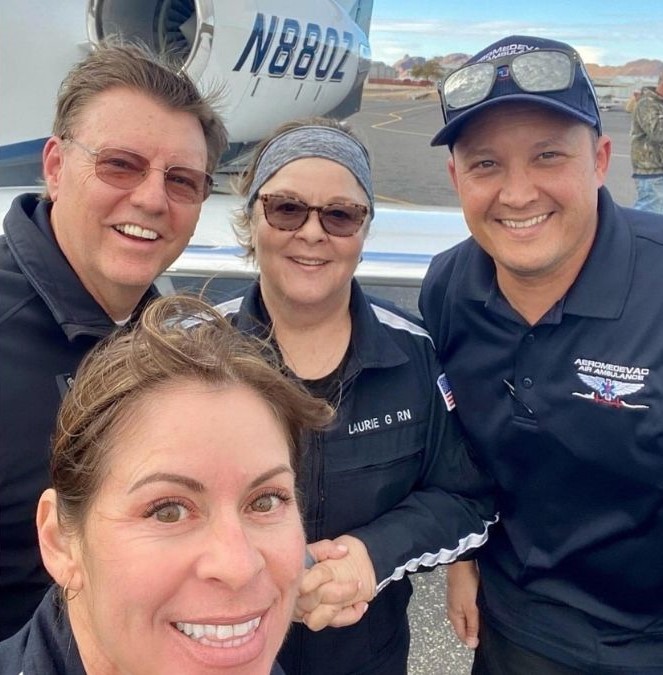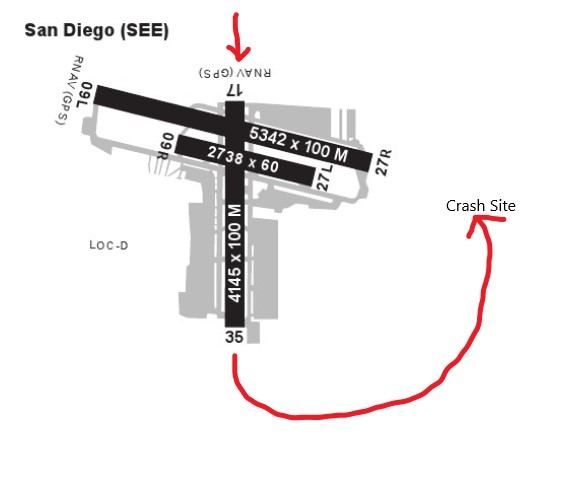Small Jet Crash in Santee Seems to be Pilot Error, All Four on Board Killed

An air ambulance jet crashed during its landing attempt at Gillespie Field in Santee two days after Christmas, killing its two pilots and two nurses who were returning from a previous transport trip, and experts now believe the accident was caused by pilot error, not mechanical problems.
The 1985 Lear 35A, call sign N880Z, owned by Aeromedevac Air Ambulance service based at Gillespie Field, was on approach to the airport during a rain storm on Monday, December 27th, and crashed at about 7:14 p.m., just 1.4 miles from the runway it was attempting to use.
Killed in the accident were pilots Julian Jorge Bugaj, 67, and Douglas James Grande, 45, as well as nurses Laurie Gentz and Tina Ward. Gentz was the President of the local union chapter of the International Association of EMTs and Paramedics.

A review of the actual air traffic control (ATC) radio contacts, as well as speed and altitude data available from the flight, show that the airplane made a precision GPS approach from the North to Runway 17, which faces nearly exactly due South.
But, as the airplane was approaching Runway 17, the pilot canceled their Instrument Flight Rules (IFR) flight plan and switched to a Visual Flight Rules (VFR) approach which allows more flexibility to pilots to navigate on their own based on visual observations.
The flight had originated from John Wayne Airport in Orange County and was on an IFR flight plan the entire way to Gillespie Field.
The pilot then asked the tower for permission to land on Runway 27 Right, an alternate runway which points due West, but would require a 260-degree left turn to re-align for a landing.

This circling turn to land maneuver is specially mentioned in the FAA landing procedures for the airport as “Not Authorized” at night due to the proximity of high terrain near the runway, but the restriction only applies to airplanes following IFR flight plans.
Canceling the IFR flight plan and switching to VFR allowed the pilot the option to use the circling approach to land.
As the pilot overflew Runway 17 he asked the tower if they could “turn up the [runway] lights for us a little bit more“, a request that may indicate that the pilot was having trouble seeing the runway in the rain and storm conditions. Airport runway lights usually have several levels of intensity that can be increased in bad weather. The tower responded that the lights were already “at 100% now.“
The request to change runways may have been planned all along because Runway 17’s length is shorter than the minimum landing distance required by a Lear 35A, especially when the runway is slick from rain.
Runway 17 is only 4,145 feet long, while the published landing distance for a Lear 35A jet is 4,333 feet of runway length. Runway 27R is 5,342 feet long.
The pilots may have decided to use the GPS approach to Runway 17 just to get them to the airport, then opted to use the visual flight rules to maneuver for a circling approach to the longer runway.
Runway 27R does have an instrument approach using localizer radio frequencies, but the GPS approach is more precise to use in inclement weather, so the pilots may have preferred to use the more modern approach during the night landing in the rain.
But high terrain near Runway 27R would make the circling approach more difficult for a fast jet, especially at night. Specifically, a 1,273 feet tall hill just to the East of Runway 27 would face the pilots as they were finalizing their left turn to line up for a landing.
Another factor working against this aircrew was the speed of the small jet. The turning radius of an airplane is greatly increased by its speed. The Lear jet was traveling at 145 knots before it crashed. Small general aviation airplanes usually make approaches at 100 knots or less.
For comparison, the turning radius of a plane traveling at 100 knots is .30 miles, whereas a plane traveling at 145 knots would have a turning radius of .65 miles, or more than twice the distance.
Adding to the difficulties for the pilots, this flight appears to have been below the minimum pattern altitude recommended at airports as it attempted its circling approach to land.
Most airports advise an attitude of 1,000 feet above the runway while in the traffic pattern, but this flight was a low as 340 feet off the ground as it began its climbing left hand turn toward Runway 27 Right.
The unlighted hill just to the East of Runway 27R is 1,273 feet tall, so the plane was at least 600 feet lower than the top of the nearby hill.
The jet only reached a maximum altitude of 562 feet above the height of Runway 27 as it was making its final turn to land before it quickly turned toward the ground then crashed on the 1200 block of Pepper Drive in the Bostonia neighborhood of unincorporated El Cajon. The accident site in just 1.4 miles from the airport.
ATC radio traffic was recorded during this flight and captured a final radio call made by the pilot as the plane began its spiral into the ground.
The radio call was only three seconds long, and only captured the pilot yelling, “Oh shit, oh shit, oh shit, ah!“, indicating he knew he had lost control of the airplane before it hit the ground.
Several professional pilots who investigate airplane accidents have reviewed the details of this flight and concluded that the pilot(s) attempted a dangerous circling approach which is not permitted at night on IFR flights and seem to have been below the recommended pattern altitude which would have left them with little room for error while maneuvering near high terrain.
Many general aviation accidents occur near runways as airplanes attempt their last turn because it is the slowest speed and lowest altitude an airplane reaches before leveling out for landing.
Under these conditions, airplanes can more easily reach the low speed and severe angles which creates an aerodynamic stall, a condition when the airflow over the wings can separate and cause the airplane to lose its lift. A stall can suddenly roll an airplane to one side, usually in the direction of the turn, and cause a spin toward the ground which would be unrecoverable at low altitude.
It is too early to determine if any mechanical issues led to the crash, including an engine malfunction or loss of controls, but eye witnesses and videos suggest that airplane was operating normally before suddenly plummeting toward the ground.
The National Traffic Safety Board (NTSB) has begun its investigation but a final report may take more than one year to complete.


 Alberto Garcia
Alberto Garcia


